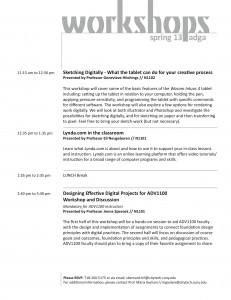Reflection
Recently I was visiting with a group of Communication Design students who were lamenting about having to take a writing-intensive course. They asked, “Why do we need to take all these writing-intensive courses, Professor? We’re visual designers.” When asked this question, my immediate answer is always “writing is a design skill.”
A designer will regularly communicate with clients or collaborators who are not designers. They will need to explain why they have made certain design choices and explain complex visual scenarios. Writing helps visual designers communicate and articulate their ideas. Before sitting down to formulate a visual solution, a designer will need to research, organize, and synthesize written information and data. Reading, writing, and critical thinking are integral to the design process.
In writing-intensive courses, whether taken as part of the Communication Design Department or General Education curriculum, students practice skills to find, evaluate, organize and communicate information. Even if they are not excited about the topic, they will gain experience in the practice and process of creative design thinking. I remind students that as designers, they will work for all types of clients, from banks to boba tea and everything in between. It’s not the subject but rather the process of finding a creative solution that is exciting. Writing is part of that process.
For the WAC Faculty WI Certification, I revised the syllabus and improved scaffolded assignments for COMD3504 Communication Design Theory. I also participated in the OER Fellowship, where I refined my openly available and clonable COMD3504 Model Course and Communication Design Theory OER, which provides faculty with a detailed course structure and assignments to improve curriculum consistency across sections.
Revising the low-stakes writing assignments (Discussions and Reading Responses) and the formal Research Paper on the Model Course site helped me rethink and refine how these learning exercises scaffold to meet the course learning objectives.
I initially developed COMD3504 to address several learning objectives missing from the curriculum and provide students with additional experience in reading, writing, and critical thinking.
- To think critically, to distinguish between fact and opinion in the analysis of different kinds of design.
- To evaluate critical and historical materials for the study of design and to construct a coherent and substantiated argument, written in clear and correct prose.
- To develop communication skills and demonstrate the ability to reflect critically on the learning process.
- To develop a historical appreciation of communication design, including designers, technologies, media, processes, creative expression, challenges, effects, and significance.
- To acquire an understanding of different forms, traditions, processes, and styles of communication design in various national and international contexts.
Between 55-70% of the coursework uses written assignments to meet the learning objectives.
- Informal writing exercises are used to research, evaluate, organize and communicate.
- Students submit critical analyses to design projects and readings via weekly blog posts.
- Students articulate thoughtful responses to critical readings or media during online written discussions.
- Students use Hypothesis to annotate difficult readings collaboratively.
- Using reflective writing in their design journals, students articulate their knowledge and opinion of design styles, movements, and history.
- Informal writing assignments are scaffolded and lead to two formal research papers and a final Research Presentation in which students identify primary and secondary sources using MLA formatted citations.
Student writing is assessed with an eye toward self-expression and clarity. In written discussion and reading responses, I encourage students to use whatever written communication skills they have to express their critical ideas about design history through social issues, politics, ethnicity, psychology, personal experience, etc. Because the content of the course is often theoretical and written for a narrow audience, I work with students to communicate in clear, well-structured, and easy-to-understand language. Having the ability and courage to write from your heart and express your spirit and personality is also important. This combined practice gives students the confidence to apply these skills to their design projects.
I am currently exploring other approaches to assessment in COMD3504, including “ungrading” and “contract grading.” I encourage students to submit a finished draft for feedback and then revise until they are satisfied with the final work. The work is not graded but is marked completed after a couple of rounds of feedback and revision or when the student feels they have met the assignment guidelines. I’m also interested in encouraging students to write with the goal of submitting work to City Tech Writer or for inclusion in student-curated essay collections. I’m looking forward to experimenting with other ways to encourage students to showcase their written work.
The WAC Writing Intensive Certification was a welcome addition to a busy semester. The experience of working with WAC Fellow Weiheng Sun was the most valuable part of the WI certification process. Weiheng provided practical suggestions for improving writing assignments that I’ve been struggling with for years. I also enjoyed the workshops but often felt the delivery of the content was not tailored to the audience. Many of the participating faculty teach and practice in STEM or STEAM fields. In some workshops I felt there was too much information presented and not enough time to digest the content. I would suggest smaller breakout rooms led by WAC Fellows to help faculty discuss and work through the content, rather than having an open-ended shareout with the entire group. Overall, an excellent experience. Thank you!
Portfolio
COMD3504 Communication Design Theory Syllabus and Schedule
Informal writing assignments that lead to a formal writing assignment.
A copy of one formal writing assignment sheet, including a rubric explaining how student writing will be evaluated.



